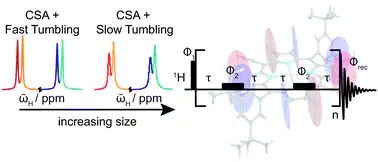
Abstract
Solution-state NMR spectroscopy remains the primary method for characterising synthetic supramolecular assemblies. Yet, in their NMR spectra, relaxation interference effects can significantly alter peak intensities hindering interpretation. Here, we present a simple experiment for synthetic chemists to analyse this effect, allowing interpretation of these distorted spectra and validation of spectral assignments. We apply this experiment to synthetic porphyrin oligomers with molecular weights approaching those of protein domains (10 kDa). Our experiment provides a simple means to gain additional structural and dynamical information that will become increasingly useful as chemists create larger molecular architectures.
Type
Publication
Chem. Commun.